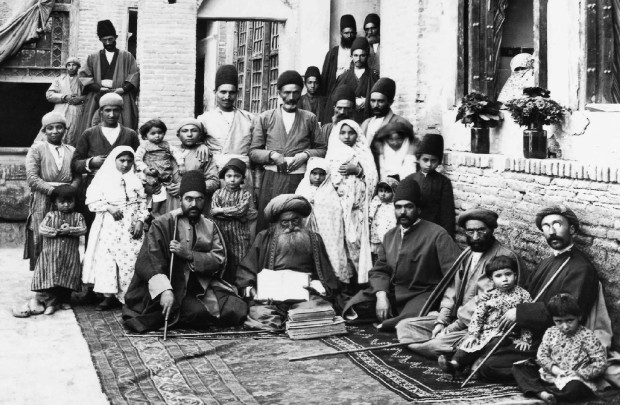Jews arrived in Iraq, then known as Mesopotamia, as slaves beginning in 721 BC, the first of three exiles of Jews from Jerusalem. When the kingdom was conquered by the Achaemenid Persians in 539 BC, they gave Jewish people the choice to return to Judea. However, many decided to stay. Thus, the origin of Babylonian Jews.
Centuries later, Jewish people played a large role in the ancient community of Iraq. A number of scholars and Rabbis were fundamental to the structuring of the country’s society. Between 500 and 700 CE, the Babylonian Talmud was collected by advanced Jewish scholars and Rabbis and proved more comprehensive than the Jerusalem Talmud.
During World War I, Britain seized control of Iraq from Ottoman Turkey and the League of Nations granted Britain a mandate to rule the nation. In 1932, Iraq became an independent state and the Jewish community subsequently played a considerable role in the advancement of the nation, including the development of the postal and judicial systems. By 1936, the “Israelite community” was recognized and listed in Iraq directories. In additiona, Hebrew was acknowledged as an official Iraq’s language. By the time World War II began, the Jewish community represented a third of Baghdad’s population. By 1948, approximately 150,000 Jews lived in Iraq. This marked the Jewish community’s peak population in Iraq.
During World War II, Iraqi Jews became the targets of violent attacks from disapproving communities influenced by the Nazi Regime. During Shavuot of 1941, Rashid Ali and members of his pro-Nazi mob attacked the Jewish community in Baghdad, known as the Fahrud or “violent dispossession”. Hundreds of Jews were killed and this event marked the beginning of the end of Iraq’s Jewish community. To stem further attacks, the British Army re-entered Baghdad.
To save Jews from further anti-semitic violence in Iraq, operation Ezra and Nechemia, a program helping bring persecuted Jews to Israel was established. The program was named after Ezra and Nehemiah who lead the Jews from Babylonia to Israel in the 5th century BC. More than 120,000 Iraqi Jews were airlifted to Israel between 1951-52 as a result of the operation.
With rising fear of the Israeli “fifth column”, strict laws were imposed on those Jews remaining in Iraq. By 1963, all Jewish people had to carry yellow identity cards. After the Arab forces lost the Six Day War, laws pertaining to the Jewish community became even stricter. Jewish properties were expropriated, businesses shut down, accounts frozen, telephones removed and more. During long periods of house arrest and travelling restrictions, many Jews felt that the only way to escape the oppression was to continue persisting and planning emigration. After learning of the persecutions of Jews in Iraq, international communities pressured Baghdad into allowing the remaining Jews to emigrate.
Today, only five Jews remain in Baghdad and one synagogue stands in Bataween, formerly Baghdad’s main Jewish neighborhood. The Meir Taweig Synagogue is the only remaining active synagogue in Iraq. While the Jewish Agency attempted to help the remaining Iraqi Jews emigrate to Israel, the ones who stay claim to be too old to move. Still, these Jews remain vulnerable to anti-semitic attacks and rarely leave their homes. However, in 2015 the Iraqi Kurdish parliament established departments to work with religious minorities and Sherzad Omer Mamsani became the Jewish Affairs representative whose role is to accommodate Jews in Iraq and maintain constructive international relations with Israel.
As of May 2018, the population of Iraqi Jews around the world reached over 300,000 with approximately 250,000 of those living in Israel. While they initially had a hard time being accepted by the Ashkenazi Jews of Israel who dominated much of the country’s social and political circles, they held strongly to their cultural roots and their culture lives on. There is a Babylonian heritage center in Israel and famous names represent their culture. For example, Dudu Tassa, who was born in Tel Aviv, became a famous rock star in the region with his performances fusing traditional Arab music and modern rock. The Iraqi Jews living around the world today still create a wide variety of their original cuisine including kubeh, a meatball enclosed in dough, as well as Baba Ganoush and other delicious recipes. Be sure to see our recipe for Iraqi Charoset and experience the flavors of Iraq! Today, Iraqi Jews continue to thrive in Israel with some hoping to one day return to Iraq and settle where their ancestors once lived.
Fun Fact:
In fact, did you know that Iraq’s first financial minister, Sassoon Eskell, was Jewish? Eskell was in office from 1925 to 1932.
Fun Fact: In 2015, the Iraqi Kurdish parliament established departments working with religious minorities with Sherzad Omer Mamsani as the Jewish Affairs Representative. His job was to accommodate Jews in Iraq and keep a constructive international relation with Israel.
Peak Population of Jews in Iraq: 156,000 in 1948
Population of Jews in Iraq Today: Fewer than 10
Population of Iraqi Jews in Israel: 450,000
Further Reading:
Justice for Jews from Arab Countries is an organization dedicated to representing Jews from Arab countries and preserving the legacy of those Jewish communities. They collect and house personal testimonies and historical accounts of Jews from Arab countries. Justice for Jews from Arab Countries provides education programs and resources so the public can learn about the history of the Jewish people in Arab countries. You can read their account of the history of the Jews in Iraq here.





